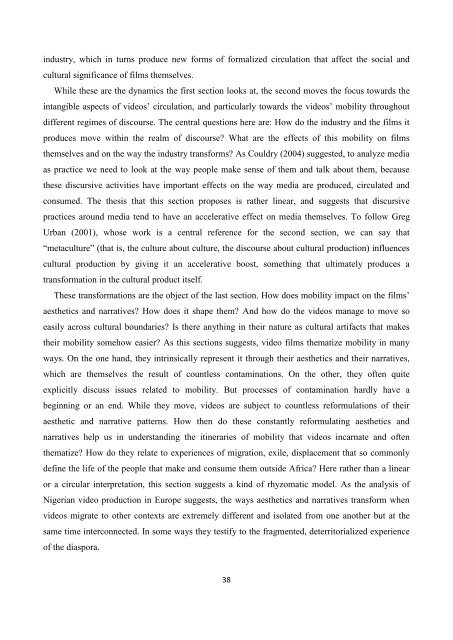Create successful ePaper yourself
Turn your PDF publications into a flip-book with our unique Google optimized e-Paper software.
industry, which in turns produce new forms of formalized circulation that affect the social andcultural significance of films themselves.While these are the dynamics the first section looks at, the second moves the focus towards theintangible aspects of videos’ circulation, and particularly towards the videos’ mobility throughoutdifferent regimes of discourse. The central questions here are: How do the industry and the films itproduces move within the realm of discourse? What are the effects of this mobility on filmsthemselves and on the way the industry transforms? As Couldry (2004) suggested, to analyze mediaas practice we need to look at the way people make sense of them and talk about them, becausethese discursive activities have important effects on the way media are produced, circulated andconsumed. The thesis that this section proposes is rather linear, and suggests that discursivepractices around media tend to have an accelerative effect on media themselves. To follow GregUrban (2001), whose work is a central reference for the second section, we can say that“metaculture” (that is, the culture about culture, the discourse about cultural production) influencescultural production by giving it an accelerative boost, something that ultimately produces atransformation in the cultural product itself.These transformations are the object of the last section. How does mobility impact on the films’aesthetics and narratives? How does it shape them? And how do the videos manage to move soeasily across cultural boundaries? Is there anything in their nature as cultural artifacts that makestheir mobility somehow easier? As this sections suggests, video films thematize mobility in manyways. On the one hand, they intrinsically represent it through their aesthetics and their narratives,which are themselves the result of countless contaminations. On the other, they often quiteexplicitly discuss issues related to mobility. But processes of contamination hardly have abeginning or an end. While they move, videos are subject to countless reformulations of theiraesthetic and narrative patterns. How then do these constantly reformulating aesthetics andnarratives help us in understanding the itineraries of mobility that videos incarnate and oftenthematize? How do they relate to experiences of migration, exile, displacement that so commonlydefine the life of the people that make and consume them outside Africa? Here rather than a linearor a circular interpretation, this section suggests a kind of rhyzomatic model. As the analysis ofNigerian video production in Europe suggests, the ways aesthetics and narratives transform whenvideos migrate to other contexts are extremely different and isolated from one another but at thesame time interconnected. In some ways they testify to the fragmented, deterritorialized experienceof the diaspora.38
















